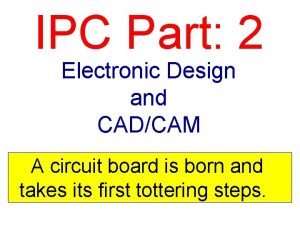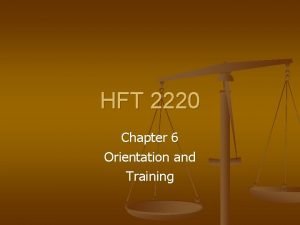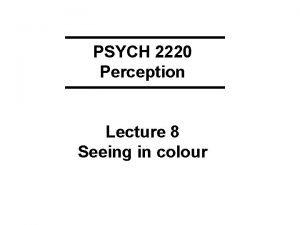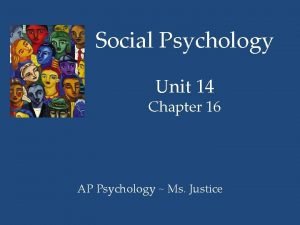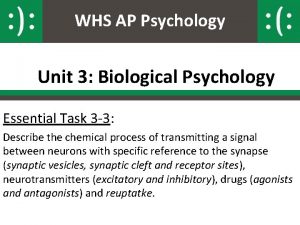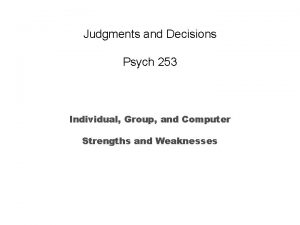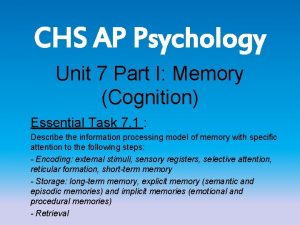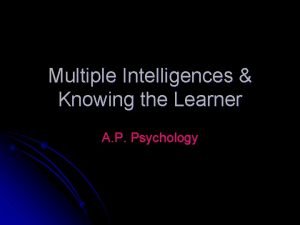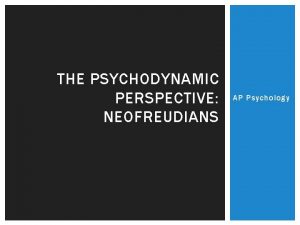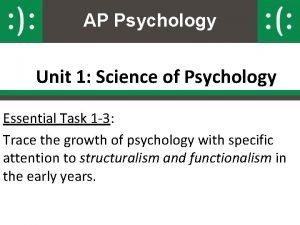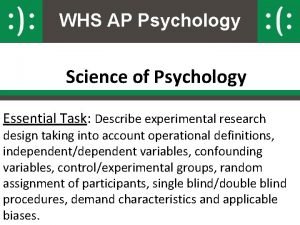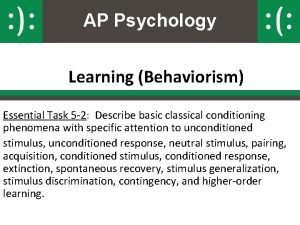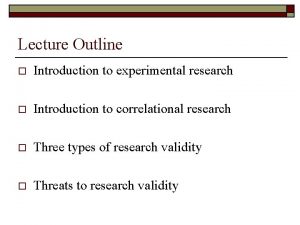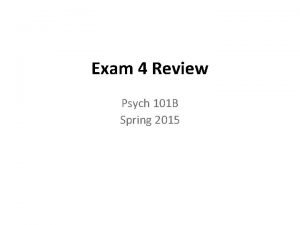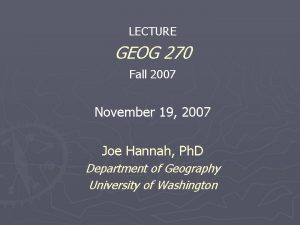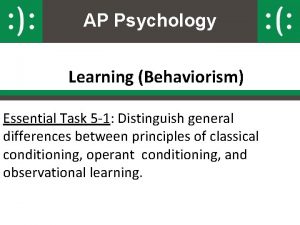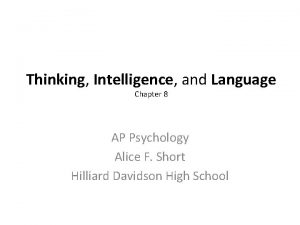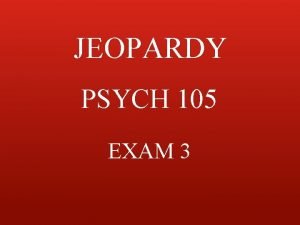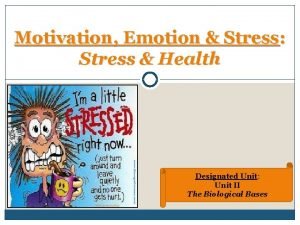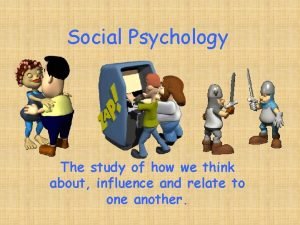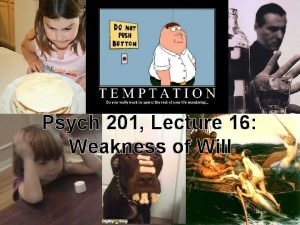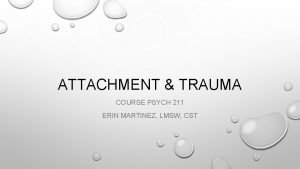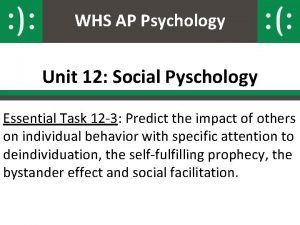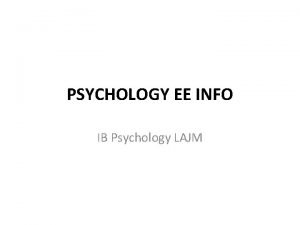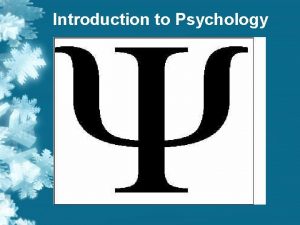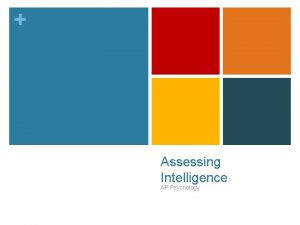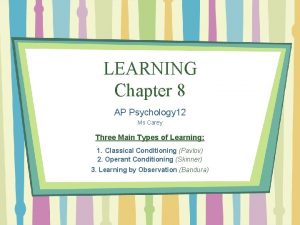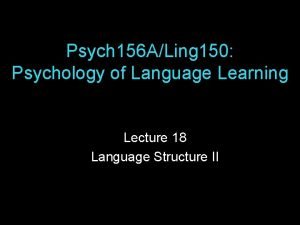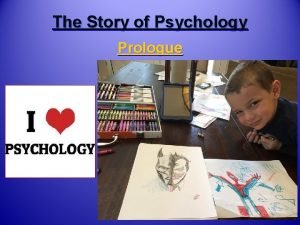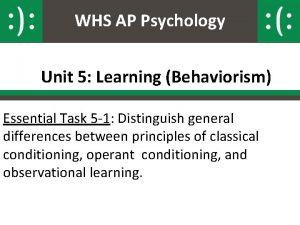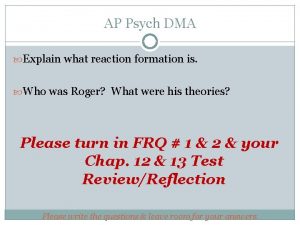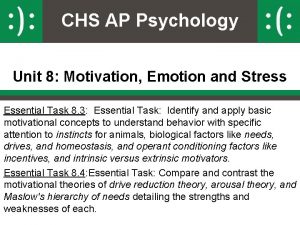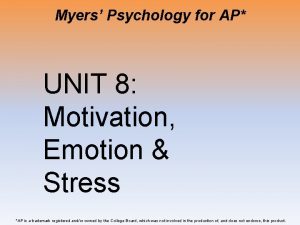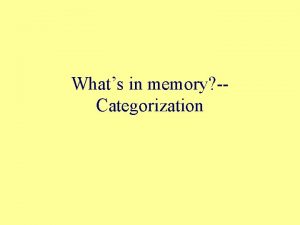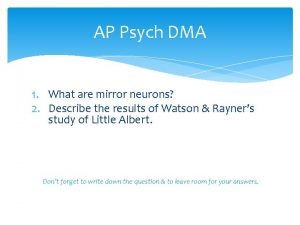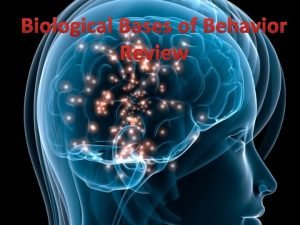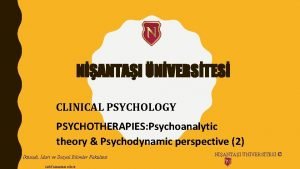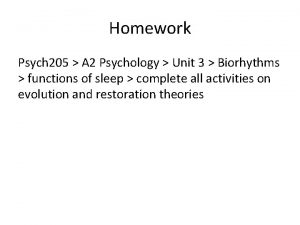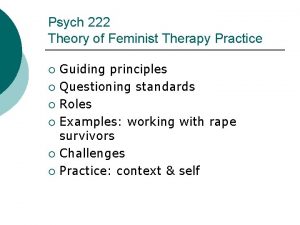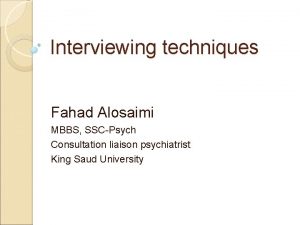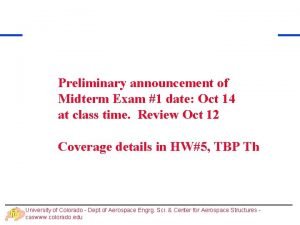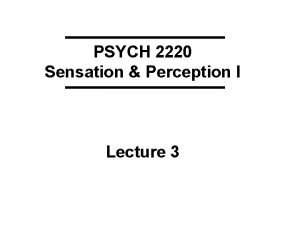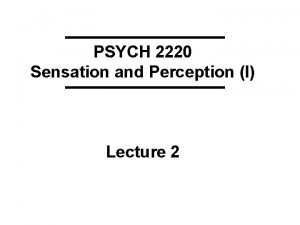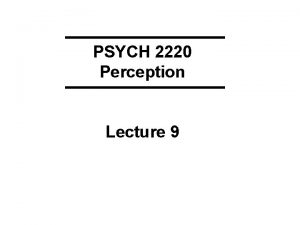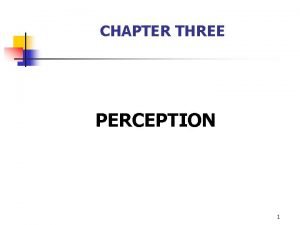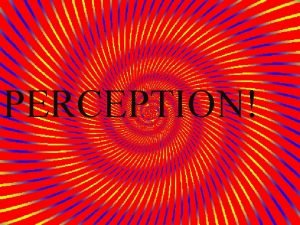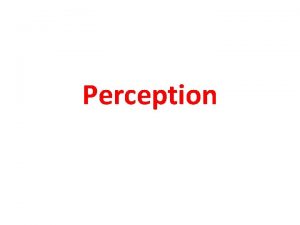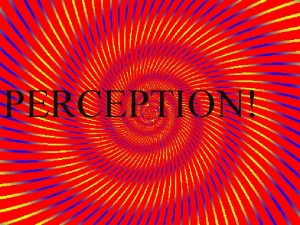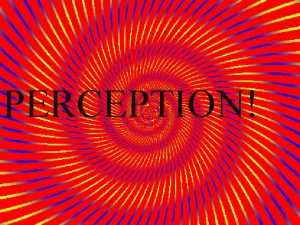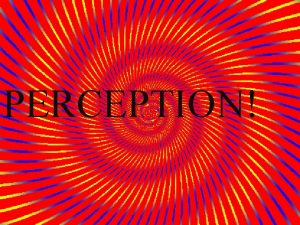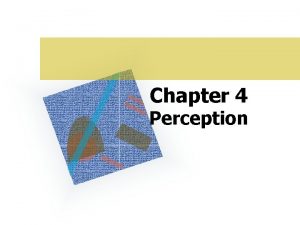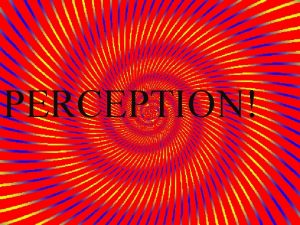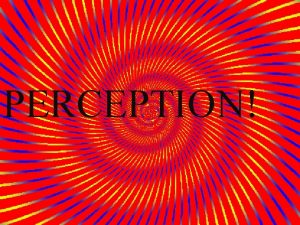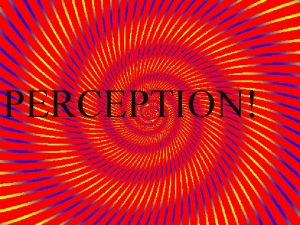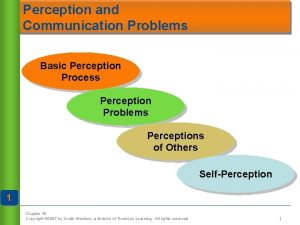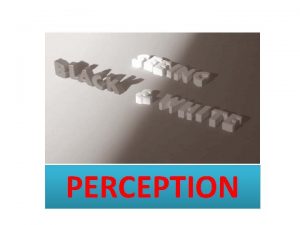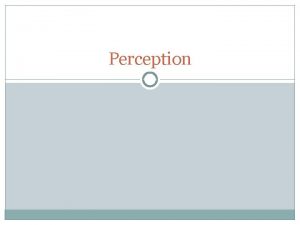PSYCH 2220 Perception Lecture 7 Go over midterm









































































- Slides: 73

PSYCH 2220 Perception Lecture 7

Go over midterm 1

KEYWORDS -- Depth Perception depth perception, artist’s cues (in order of importance: overlay, perspective, texture gradient, size), playing card illusion, size constancy, Ames room, impossible triangle, moon illusion (1), stereopsis, parallax, stereograms (demo), random dot stereograms (demo), disparity tuned cells, Pulfrich's pendulum (demo), accommodation (as a cue to depth), visual cliff, autostereograms, motion-in-depth tuned cells -- demo of stereopsis versus size

Demo of stereopsis vs size you Cross eyed 2 coins

FAR CELL RIGHT EYE FAR NEAR LEFT EYE

NEAR CELL RIGHT EYE FAR NEAR LEFT EYE


Visual motion

The scrabble game by David Hockney

Distinguishing eye movements from object motion inflow/outflow autokinesis saccadic suppression

“outflow” “corollary discharge”

“inflow”

EXPERIMENTS PREDICTIONS INFLOW OUTFLOW DATA Active motion of real image No movement Passive motion of real image No movement YES movement Active motion of after image YES movement Passive motion of after image YES movement No movement Attempt to move paralyzed eye No movement YES movement

DEMO gently push eye


EXPERIMENTS PREDICTIONS INFLOW OUTFLOW DATA Active motion of real image No movement Passive motion of real image No movement YES movement Active motion of after image YES movement Passive motion of after image YES movement No movement Attempt to move paralyzed eye No movement YES movement

Autokinesis

Autokinesis “auto movement” When a light appears to move around on its own. “outflow” “corollary discharge”

DEMO saccadic suppression look in mirror

Distinguishing eye movements from object motion inflow/outflow: outflow most important autokinesis drift without outflow saccadic suppression because of corollary discharge

OBJECT vs BACKGROUND


INDUCED MOVEMENT

CORTICAL BASIS OF MOTION PERCEPTION object motion needs distance motion after effect cortical responses clinical lesions to area “MT”

Why planes appear to move so slowly. . . Illustrate what needs to be done to perceive object motion. It needs distance.

small thing close big thing far

Moon illusion 2 Why the moon moves with you. . .




left 10 right - + 10 compare 0 “no movement”

left 20 right + - 5 compare +15 “movement left”

left 5 right + - 20 compare -15 “movement right”

AFTER ADAPT LEFT left 7 right + - 10 compare -3 “movement right”

motion processing visual cortex motion processing


Lesions in the medial temporal region of the cortex cause MOTION BLINDNESS

visual cortex

visual cortex

biological motion visual cortex biological motion

CORTICAL BASIS OF MOTION PERCEPTION object motion needs distance integration of info motion after effect coding by comparison cortical responses motion areas in the brain visual cortex (simple cells) MT cells using corollary discharge STS cells processing biological motion clinical lesions to area “MT” motion areas in the brain

Self motion vision isn’t all there is…

CUES TO MOTION PHYSICAL FORCES (picked up by the vestibular system)

Otoliths (ear stones)

angular movement (rotation) linear movement (translation) Otoliths (ear stones)

CUES TO MOTION physical forces TRANSLATION

CUES TO MOTION physical forces ROTATION

KINOCILIUM afferent fibre hair bending this way…. causes depolarization


Optic flow can generate VECTION

Vection video

Vision alone Vestibular alone Nystagmus eye movements

Self motion and ALCOHOL 1 alcohol -> canals 2 alcohol rises and moves the fluid 3 causes head to feel tilting DOWN 4 eyes move UP 5 retina past still world -> visual world moved DOWN 6 visual vection created suggesting head tilting. UP 7 head up and down at same time? 8 Must be poisoned. 9 GET RID OF IT!!!!

vision gravity MOTION SICKNESS in a boat cabin….

MOTION SICKNESS gravity n o visi MOTION SICKNESS in a boat cabin….

SELF MOTION vestibular system: can help distinguish external from self motion can remove some motion due to self motion by eye movements: tends to keep background fixed on retina Visual and vestibular cues can work together to tell you about your self motion (guiding and navigating)

MECHANISMS OF MOTION PROCESSING integration across TIME and SPACE

CRITICAL FLICKER FUSION FREQUENCY

CRITICAL FLICKER FUSION FREQUENCY 50 hz in centre 100 hz in periphery 200 hz in cats (hz stands for Herz which is 1 cycle/second)

CRITICAL FLICKER FUSION FREQUENCY tells us about what period of TIME is integrated in calculating motion (if something is at 50 hz it repeats every 1/50 th sec… that is every 20 milliseconds) can be exploited in film and tv and computers…

CRITICAL FLICKER FUSION FREQUENCY Modern movies are projected at 48 hz with each picture being shown twice (i. e. at 96 hz) Typical computer screen refresh is similar.

STROBE DEMO not fused!!!

APPARENT MOTION Things have to be close together in both SPACE and TIME to appear to move.

APPARENT MOTION demo LIGHT 1 LIGHT 2 on off close together in time

So now we need a model that will a) b) c) d) Explain normal motion perception Produce motion after effects Not work faster than CFFF Mix up apparent motion and real motion THERE ARE TWO CANDIDATES: Inhibition model Delay model

INHIBITION MODEL A B C Receptive fields input cells A B C C B A motion detector cells

INHIBITION MODEL A B C Receptive fields input cells motion detector cells comparison cell

INHIBITION MODEL Receptive fields input cells motion detector cells comparison cell

INHIBITION MODEL A B C Receptive fields input cells motion detector cells comparison cell

DELAY MODEL medium delay long delay medium short yes!! short delay short medium long delay no!!

DELAY MODEL Receptive fields input cells motion detector cells comparison cell

DELAY MODEL Receptive fields input cells motion detector cells comparison cell

Summary of the motion class: Distinguishing eye movements from object motion Inflow/outflow most important autokinesis (drift without outflow) saccadic suppression using corollary discharge Object vs background Cortical basis needs distance MAE cortical responses (including biological motion) can be lost clinically Self motion vestibular, canals, otoliths, eye movements, vection Mechanisms: integrate over space and time CFFF/strobe, motion after effect, apparent motion inhibition model, delay model
 Relative height ap psychology
Relative height ap psychology Ipc 2221
Ipc 2221 Hft 2220
Hft 2220 Seeing 2220
Seeing 2220 01:640:244 lecture notes - lecture 15: plat, idah, farad
01:640:244 lecture notes - lecture 15: plat, idah, farad Over the mountain over the plains
Over the mountain over the plains Siach reciting the word over and over
Siach reciting the word over and over Explain how to handing over and taking over the watch
Explain how to handing over and taking over the watch Availability heuristic ap psychology
Availability heuristic ap psychology Normative social influence ap psychology
Normative social influence ap psychology Ap psych unit 12
Ap psych unit 12 Frc psych
Frc psych Psych 253
Psych 253 Unit 7 ap psych
Unit 7 ap psych Howard gardner ap psychology
Howard gardner ap psychology Karen horney ap psychology
Karen horney ap psychology Mt sac psych tech
Mt sac psych tech Ap psych unit 1
Ap psych unit 1 Krisennetzwerk unterfranken
Krisennetzwerk unterfranken Independent variable
Independent variable Ap psych unit 9
Ap psych unit 9 Rudolf skobe
Rudolf skobe Extinction ap psychology
Extinction ap psychology Examples of operational definition
Examples of operational definition Psych 101 exam 4
Psych 101 exam 4 Sodas ap psychology
Sodas ap psychology Psych 270a
Psych 270a Social learning theory ap psychology
Social learning theory ap psychology Aacandautism
Aacandautism Groupthink vs. group polarization
Groupthink vs. group polarization Thinking, language and intelligence psychology summary
Thinking, language and intelligence psychology summary Psych 105
Psych 105 Ap psychology thinking language and intelligence
Ap psychology thinking language and intelligence Lazarus ap psych
Lazarus ap psych Cognitive dissonance
Cognitive dissonance Hot cold empathy gap
Hot cold empathy gap Classical conditioning
Classical conditioning Antisocial personality disorder ap psychology definition
Antisocial personality disorder ap psychology definition What is a met call
What is a met call Psychology unit 7
Psychology unit 7 Rupture cda
Rupture cda Near-death experiences are ap psych
Near-death experiences are ap psych Module 47 infancy and childhood cognitive development
Module 47 infancy and childhood cognitive development Shaping adalah
Shaping adalah Superordinate goals psychology definition
Superordinate goals psychology definition Behavior geneticists ap psych
Behavior geneticists ap psych Social loafing ap psychology definition
Social loafing ap psychology definition Abnormal psychology ee topics
Abnormal psychology ee topics Ucf psych advising
Ucf psych advising Proximodistal development
Proximodistal development Binet ap psych
Binet ap psych Ms carey ap psych
Ms carey ap psych Mse in psychology
Mse in psychology Edo psych
Edo psych Cand psych
Cand psych What is habituation in psychology
What is habituation in psychology Psychology memes
Psychology memes Behaviorism ap psychology definition
Behaviorism ap psychology definition Freud meets mother goose
Freud meets mother goose Unit 8 ap psychology
Unit 8 ap psychology Psych 112
Psych 112 Unit 8 myers ap psychology
Unit 8 myers ap psychology Prototype psychology
Prototype psychology Mirror neurons ap psych
Mirror neurons ap psych Brain lateralization refers to the ap psych
Brain lateralization refers to the ap psych Self projecting
Self projecting Mental health nursing process
Mental health nursing process Psych 205
Psych 205 Ap psychology unit 6 learning
Ap psychology unit 6 learning Psych 222
Psych 222 Mse psych
Mse psych Jmu psych checklist
Jmu psych checklist Psych
Psych Midterm exam announcement
Midterm exam announcement

